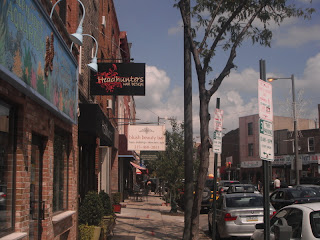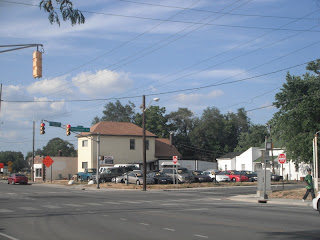A few years ago, I surveyed storefronts across the downtown of Cambridge, Massachusetts, interpreting their various placard signs as a proxy for the evolution of a city whose demographics and character have changed significantly over the years. As Cambridge has morphing from a tired, intermittently gritty bohemian college town into an upscale tourist destination, the few local establishments that have clung to their now primo locations stand out like “a Chevy Malibu parked among all the Volvos and Audis”, to use my apt analogy from a few years ago. Many of Cambridge’s retail newcomers have been national upscale chains like Talbot’s or Crate and Barrel. As a contrast, the remaining local stores have ardently retained their aging faded signs as an icons of distinction, no doubt hoping to inspire a particular reaction among visitors to Cambridge: “That place must me a local institution; look how old the sign is!”
I would never claim to say that Cambridge’s transformation
is complete or fully-realized. Cities
are perpetually volatile, and its next phase may invoke something that no one
can anticipate, reflecting the tastes of a consumer contingent that does not
yet exist. Whatever the future of
Cambridge, its gentrification is unambiguously more pronounced than East
Passyunk, the South Philadelphia neighborhood featured in this blog post.
Long a stronghold of the region’s Italian-American
community, South Philly has evolved considerably over the last three or four
decades—from an overwhelmingly working and lower-middle class stronghold of the
region’s Italian-American community to a patchwork of varied demographics:
impoverished African American and southeast Asian neighborhoods, Mexican
vendors in the formerly exclusively Italian market, a small (and shrinking)
Irish enclave clinging valiantly to survival along the Delaware River, a
tsunami of young professionals surging from the north, and, yes, quite a few squares
in the quilt that remain resolutely blue-collar Italian. When I lived in Philadelphia in 2004,
the East Passyunk corridor was one of them. Just a few blocks away from the economically disadvantaged
Point Breeze neighborhood on the other side of Broad Street, East Passyunk no
doubt looked very much the same as it did in the 1950s. The storefronts featured family-run dry
cleaners, hardware, bakeries, tailoring, convenience stores, and so forth.
Not anymore. In
the ensuing eight years, the infantry of yuppies that had aready stormed the
affluent Bella Vista neighborhood decided to push their front line further
south. They probably found East
Passyunk more affordable, more relaxed, maybe a tiny bit easier to park the
cars. Home values have tripled in
the last decade, and quite a few of those mom-and-pop establishments I
recognized have morphed into fair trade coffee shops, pilates studios, sushi
bars—you know the drill.
Interestingly, several of the standby Italian eateries
remain in the neighborhood but have themselves gentrified, offering a few more
gourmet menu options as a response to the more moneyed demographic (or, more likely,
the same beloved specialties as before but at a higher price). Take this one, for example, which I
don’t believe is anything fancy, but apparently it recently spruced itself up
considerably:
Some of these old standbys now offer valet parking, which
would have seemed ridiculous along East Passyunk twenty years ago, but again
demonstrates both a response to a clientele that is not only more likely to own
cars, but they would also have no qualms shelling out an extra Andrew Jackson
to shift the burden of parking that vehicle onto someone else.
Many of the long established Italian-American families
remain, and not all of the traditional retail has fled or capitulated to yuppie
encroachment. A quick scan across
the commercial corridor at any point reveals the bifurcated income levels, and
all it takes is a look at those signs.
Take, for instance, this very typical view along the sidewalk at a more
southerly portion of East Passyunk Road:
And the storefront on the opposite side of the street:
In contrast with downtown Cambridge, I cannot detect very
much conscious interplay between the old and new signage here. The old signs in East Passyunk offer
less untapped semantic content than the vintage marquees of Harvard Square; the
elder businesses here in South Philadelphia don’t need to distinguish
themselves from upmarket national chains, because, at this point, virtually
nothing in the neighborhood is a chain.
So in East Passyunk, the age of signs connotes one obvious distinction:
income. Old signs equate to old
businesses, which are the domain of the working class families who have lived
here for generations. Only very
recently have these households sat cheek-by-jowl in rowhomes filled with
affluent professionals.
The income/education disparity manifested by these signs
does not at this point seem like a heated kettle ready to boil over. They seem to co-exist peacefully in
general. But one sign in
particular demonstrates the chasm in consumption patterns between neighbors
better than any of the others.
It’s hard to find an online reference to King of Jeans that
doesn’t feature such adjectives as “iconic”, “landmark”—even “spectacular”. The
size of the sign doesn’t hurt. As
the woman in pink at the lower-right of the photo indicates, it’s huge—it
spreads across three full stories and a cladding that conceals four buildings
cobbled together. But the content
of the sign is what makes it truly irresistible for some. Part roller disco, a little
greaser-rebel, a soupcon of S&M, and a healthy dose of now broadly-known
Guido culture, the sign’s ability both to bewilder and offend has elevated it
to the level of a South Philly meme.
If King of Jeans intends to evoke something, the owner sure ain’t
telling, but that’s part of its mystique.
In fact, the owner might not be doing much besides fighting his or her
way through court: evidently King of Jeans is seriously tax delinquent,
which may explain why the conspicuously old-time vendor (confirmed by the
signage) is closing the store after so many years. Is the inevitable demise of King of Jeans a further symptom
of considerable gentrification?
Perhaps the combination of low sales (shrinking old-school South
Philadelphian clientele) and high costs (more taxes due to escalating property
values) stymied the long-profitable business.
The real indicator of things to come: a local developer hasbought the property and has proposed to transform it into apartments, offices,
and retail. Now the East Passyunk fan base has
begun rallying behind that sign.
While everyone seems to concede that it can’t remain at its current
location—a building whose upper-level fenestration got sheathed decades ago
(just as it did across American commercial districts in the 1950s, and I
blogged about it recently http://dirtamericana.blogspot.com/2012/08/nostalgic-for-future.html)
--most agree that it should never leave Philadelphia. The developer has agreed to salvage it, and ideally it will
remain in South Philly. But all this
buzz merely demonstrates the polyphony of taste cultures who ostensibly feel a
certain degree of stewardship over neighborhood relics such as King of
Jeans. Nobody who patronizes the
street’s new sushi bars and acupuncture studios genuinely believe the sign is
awesome or spectacular. Rather, the
yuppie/hipster denizens (whose consumer tastes merge more often than either constituent
is willing to admit) share a fondness for irony, which does not preclude them
from mocking the potentially more lowbrow tastes of the working-class families
who’ve lived in the neighborhood for decades. Yet the swirl of opinions and emotions surrounding this
simultaneously sleazy/kitschy sign is more complicated than this, because no
evidence exists that the long-established Italian American families cherish the
sign or the establishment any more than the yuppies do. Sure, the two stakeholders here might
find common ground at a quality, long-familiar restaurant or bakery, but tastes
in apparel are simply too ephemeral and too demographically precise for a store
such as this to adapt very easily.
Restaurants often suffer if they deviated from long-proven model;
clothing stores will die if they fail to change. It’s likely that the King of Jeans was ready to descend from
his throne, regardless of tax delinquent status.
One final rumor further beclouds any further analysis of
the-sign-that-nobody-loved-until-now: several native Philadelphians can attest
that it isn’t even that old.
Thirty years tops, but possibly only twenty. Nowhere near as old as some of the legitimate institutions
that have survived the encroachment of the creative class on East Passyunk. If the rumors are true, the sign for
the King of Jeans warrants an entirely new aesthetic reconciliation. Did the proprietor deliberately design
it to look old and faded, so it would appear as old as some of the mom-and-pops
nearby? Were the owner’s promotional
sensibilities so tongue-and-cheek that he could anticipate a market hungry for
ironic cultural references, for cheesy vintage signs? Was the owner trying to stimulate nostalgia among the
working class Italian American demographic that exclusively lived there at the
time, or is the sign merely trying to provoke them?
More likely than not, I’m imposing a level of consciousness
into this collision of cultures by interpolating a conflict that doesn’t
actually exist. In a matter of
weeks, King of Jeans will be gone, and the building that houses it will undergo
a complete facelift. No doubt the first
floor will eventually house a slow food kitchen, a Cambodian gastropub,
designer apparel for dogs, vegan cheesesteaks, or similarly themed retail
catering to the neighborhood’s cadre of bourgeois bohemians. All with brand-new signage further
shifting the old-to-new balance in favor of the latter. Unless these stores’ proprietors choose
a deliberately old-fashioned, outdated, or unfashionable type of signage (I’m
thinking tungsten filament lightbulbs—not green but still worth as a retro hat-tip)
to meet the newcomers’ insatiable appetite for cheeky irony. And the appreciation and
commodification of irony—more than educational attainment, income levels, or
number of children—may ultimately prove the wedge that divides the two camps
here in Philadelphia’s least heated class war.




























































